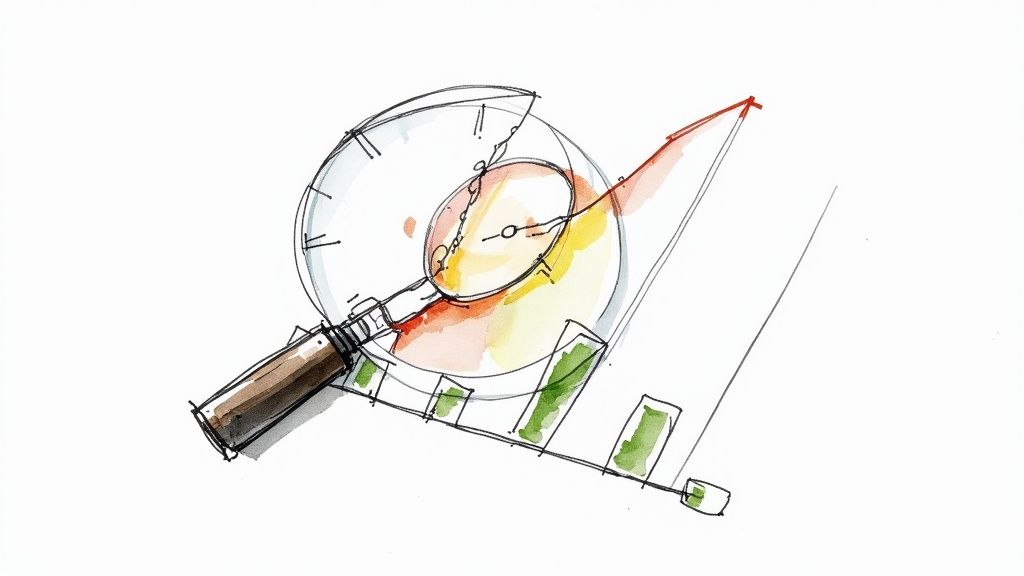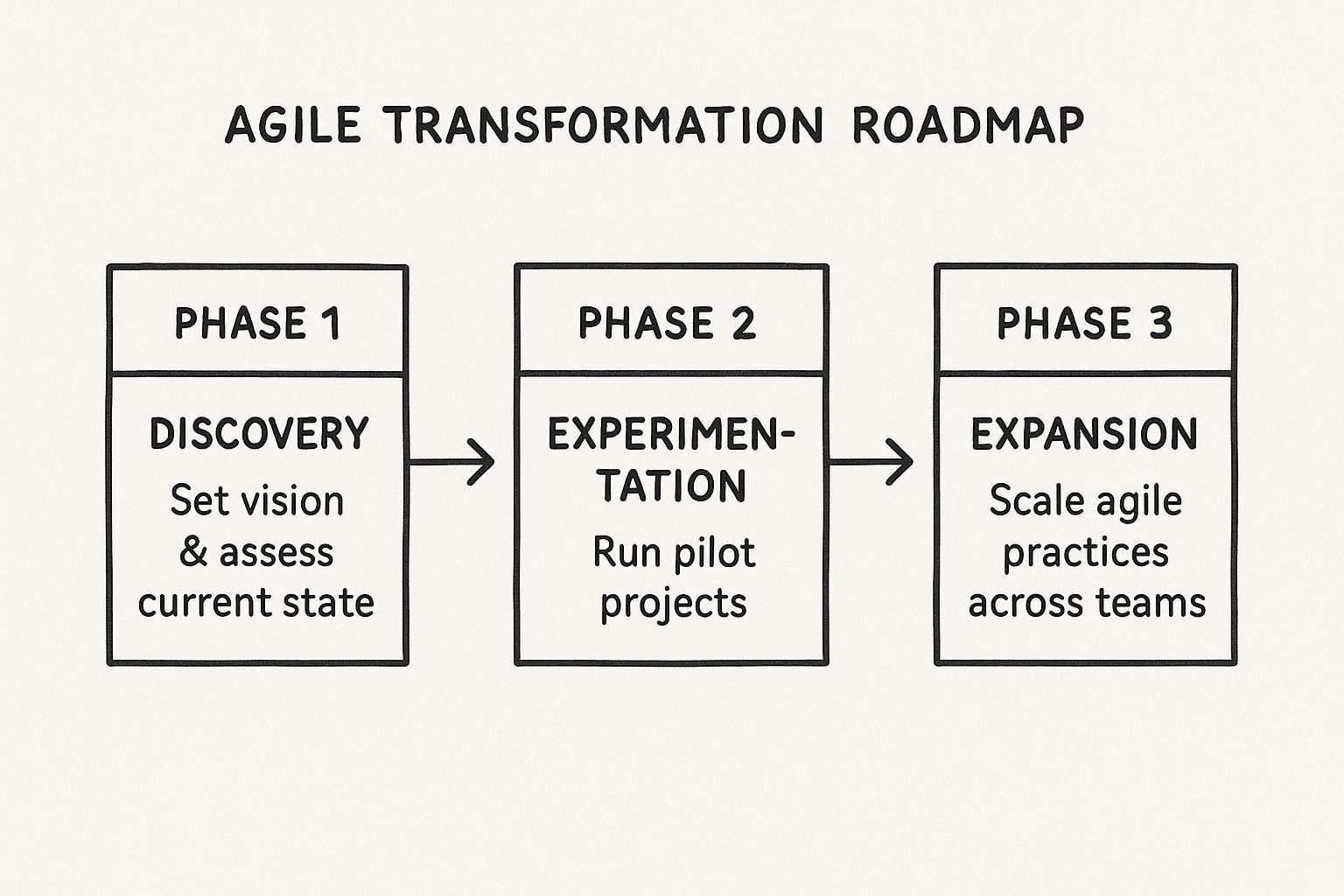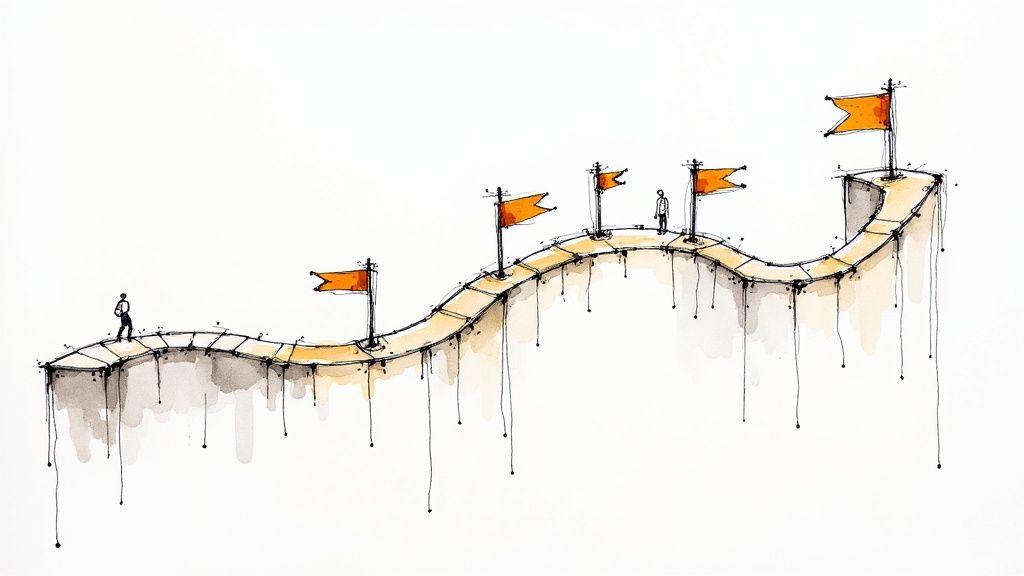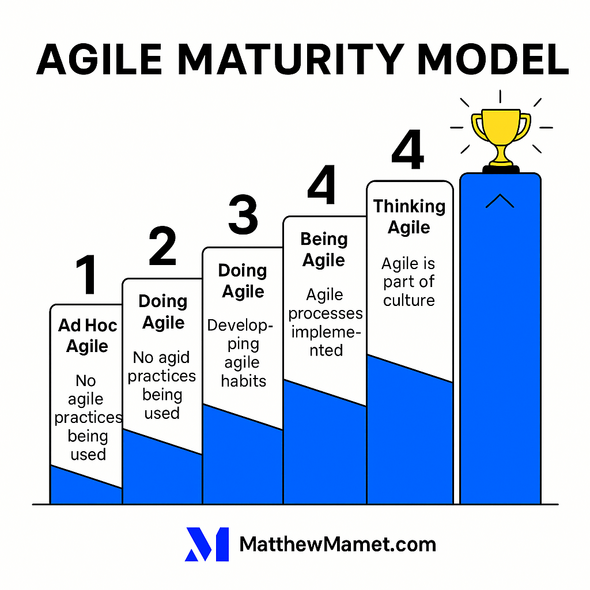Table of Contents
An agile transformation roadmap is a strategic plan that maps out the vision, goals, and steps for shifting your organization toward agile principles. But let's be clear: this isn't some rigid project plan you lock in a drawer. Think of it as a living document—a guide for the cultural and operational overhaul required to build real, lasting business agility.
Laying The Groundwork For Lasting Agile Success
Before a single sprint gets planned or the first team is formed, the most successful transformations I've seen all start with a clear-eyed, honest look inward.
Too many leaders get excited and jump straight into implementing frameworks like Scrum or Kanban. The problem? Without a strong foundation, these efforts quickly become "agile theater"—you're going through all the motions, but you aren't seeing any real results. The first, most critical step is defining what success actually looks like for your business.
This means getting past the buzzwords. What specific, measurable outcomes are you actually after? Is it shipping new features faster? Is it improving product quality and cutting down on bugs? Or is it about boosting team morale and keeping your best people? Nailing down these goals gives you the "why" that will anchor your entire journey.
Conduct a Candid Organizational Readiness Check
Ready to drive more growth & achieve bigger impact?
Leverage my 25+ years of successes and failures to unlock your growth and achieve results you never thought possible.
Get StartedOnce you have a clear vision, it’s time for an honest assessment of where you are right now. This isn't just about your tech stack or current processes; it’s about your culture. I’ve seen it time and again: an organization's existing culture is often the single biggest roadblock to becoming truly agile. A candid readiness check helps you spot these hurdles early, before they completely derail your progress.
Start by asking tough questions about these key areas:
- Leadership Mindset: Do your leaders operate with a command-and-control style, or are they genuinely prepared to empower teams and trust them to deliver?
- Team Autonomy: Are teams micromanaged to death, or do they have the freedom to make meaningful decisions about their own work?
- Psychological Safety: Is it actually safe for people to experiment, fail, and speak up with new ideas without fearing blame? A culture of fear is where agility goes to die.
- Organizational Silos: How much friction is there between departments like engineering, product, and marketing? Are they partners or adversaries?
A huge part of this groundwork is framing the business value in a way everyone gets. Don't say, "We need to be more agile." Instead, try: "We need to cut our feature delivery time by 30% to win more customers." This simple shift connects the transformation to tangible results and makes it much easier to get stakeholder buy-in.
Establish Your Foundational Infrastructure
Your technology also has to be ready for this new way of working. Agile teams need tools and infrastructure that are built for speed, collaboration, and continuous delivery.
To build a solid base, it's worth digging into how modern infrastructure fuels business agility. Understanding the top benefits of cloud computing for businesses can show you how to empower your transformation from the ground up. If you're new to the core concepts, our guide on agile software development is a great place to build your knowledge. This foundational work—across people, process, and technology—creates the unshakeable base your entire roadmap will depend on.
Aligning Leadership And Defining Your Scope
Before you write a single line of your roadmap, you have to get your leadership team on the same page. A united front isn't just a nice-to-have; it's the foundation for everything that follows. An Agile transformation without genuine executive sponsorship is a ship without a rudder. It’s not going anywhere good.
This isn't about getting a passive nod in a meeting. Your job is to turn skeptics into active, vocal champions for this change.

From my own experience, the quickest way to do this is to stop talking about process and start talking about outcomes. Forget Scrum ceremonies and story points for a minute. Frame the discussion around beating competitors to market, growing revenue, or capturing more market share. Connect Agile directly to the business metrics they live and breathe every day. When they see how this helps their goals, their entire posture changes.
From Passive Agreement To Active Championship
Ready to drive more growth & achieve bigger impact?
Leverage my 25+ years of successes and failures to unlock your growth and achieve results you never thought possible.
Get StartedSo what does a true champion look like? It’s a leader who doesn't just sign the checks. They actively model the behaviors you want to see. They’re visible, they’re vocal, and they consistently reinforce the "why" behind this whole effort.
Here’s what this looks like in the real world:
- They celebrate learning, not just wins. When a pilot team’s experiment flops, a championing leader publicly praises the team for the guts to try and for the insights they gained. They don't punish the outcome.
- They clear the path. The executive sponsor becomes the go-to person for smashing organizational roadblocks, whether that means reallocating resources or breaking down a silo between two stubborn departments.
- They show up. A leader who drops into a sprint review and asks smart questions sends a powerful message to everyone: this work matters.
This level of commitment is what separates the transformations that stick from those that fizzle out. It’s no surprise that the market for enterprise Agile transformation services is projected to grow at a 19.5% CAGR through 2026. This isn't a fad; it's a strategic imperative.
The data backs this up. In organizations where 52% of employees feel empowered by their leaders, Agile adoption skyrockets. These companies see a stunning 237% increase in commercial performance. You can dig into more of these numbers in these agile adoption statistics.
The goal isn't just buy-in; it's belief. Leaders must genuinely believe in this new way of working and be willing to change their own habits first. Their actions will always speak louder than any company-wide memo.
Collaboratively Defining Your Initial Scope
With your leadership aligned and fired up, it’s time to get realistic about where to start. The temptation to transform the entire organization overnight is huge. Resist it. I always tell leaders to start small with a well-defined pilot. Your goal is to create a "lighthouse" project—a clear, shining example of success that the rest of the organization can look to.
Choosing that first pilot depends entirely on your company’s context. A few common starting points I’ve seen work well:
| Starting Point | Best For | Key Considerations |
|---|---|---|
| A Single Team | Organizations new to Agile or with high cultural resistance. | Pick a team that's motivated and working on something visible. You want an early win. |
| A Full Department | Businesses with strong departmental leadership and shared goals. | Make sure the department head is a true Agile champion, not just a bystander. |
| A Value Stream | Companies ready to tackle cross-functional collaboration head-on. | This is more complex but offers massive value by optimizing an end-to-end flow. |
Once you've picked your starting point, work with the team and leadership to set clear, measurable objectives. You have to agree on what success looks like before you begin.
Is it cutting cycle time by 20%? Is it boosting a key customer sat score by 10 points? Nailing these targets down ensures everyone—from the C-suite to the pilot team—is pulling in the same direction from day one.
Ready to drive more growth & achieve bigger impact?
Leverage my 25+ years of successes and failures to unlock your growth and achieve results you never thought possible.
Get StartedDesigning The Core Phases Of Your Roadmap
Once you have leadership alignment and a decent handle on the initial scope, it's time to actually build the roadmap. But let's be clear: this isn't a static project plan with rigid dates stretching years into the future. That’s a recipe for failure. Instead, think of this as a strategic guide—a living document that maps your journey through logical phases and adapts to reality as you learn.
The most effective agile transformations I've ever been a part of always progress from focused learning to broad scaling. It’s a phased approach that de-risks the entire initiative. You get early wins, you gather crucial data, and you build momentum that becomes unstoppable. The most common pitfall I see is leaders trying to do too much at once, which just spreads resources thin and kills focus before you even get started.
This flow provides a simple but powerful structure for your roadmap.

Moving from discovery to expansion gives you a clear, progressive path. It prevents teams from getting overwhelmed and ensures each stage builds on the success of the last.
The Discovery And Pilot Phase
Your first phase is all about controlled experimentation. The goal here is to launch your first pilot projects with a handpicked, motivated team. And the primary objective isn't just finishing a project; it's to learn as much as possible about how agile actually works inside your company’s unique culture and constraints.
During this discovery phase, you’ll want to:
- Provide intensive training and coaching for the pilot team and their direct managers. This is non-negotiable. You can't just throw them in the deep end.
- Select an initial framework like Scrum or Kanban. Don't overthink it. Just pick one and start. Scrum is great for complex projects with defined chunks of work, while Kanban is fantastic for managing continuous workflow.
- Establish baseline metrics. You can't prove you're getting better if you don't know where you started. Track basics like cycle time, lead time, and even team happiness.
Ready to drive more growth & achieve bigger impact?
Leverage my 25+ years of successes and failures to unlock your growth and achieve results you never thought possible.
Get StartedThis phase is where you work out the kinks in a low-risk environment. It's your chance to prove to the rest of the organization that this new way of working actually delivers real results.
The Expansion And Refinement Phase
Once your pilot team has a few successful sprints under their belt and you have the data to prove it, you can move into the expansion phase. This is where you begin to carefully scale what you’ve learned works. You’ll use the successes—and failures—from your pilot team as a "lighthouse" to guide other teams.
A critical mistake here is enforcing a one-size-fits-all model. Just because the pilot team had great success with Scrum doesn't mean every team should use it. A customer support team might get more value from Kanban's flow-based approach, while a research team might need something totally different.
The key is to empower teams to choose the framework that best fits their work, while providing them the coaching and support they need to succeed. This is also the time to formalize your communication plan—share success stories, publish key learnings, and get out in front of the inevitable skepticism.
Continuous Improvement And Enterprise Agility
The final phase is less of a destination and more of a new state of being. Your focus shifts from implementing agile to being agile. The goal is to embed a culture of continuous improvement, or Kaizen, directly into the company's DNA. This is where the real, lasting change happens.
For a deeper look at creating roadmaps that evolve over time, our guide on how to create a product roadmap offers some valuable insights that apply here, too.
To give you a clearer picture, here’s a high-level look at how these phases might break down in practice.
Sample Agile Transformation Roadmap Phases
| Phase | Primary Focus | Key Activities | Estimated Duration |
|---|---|---|---|
| Phase 1: Discovery & Pilot | Learning & Validation | Select 1-2 pilot teams, provide intensive training, establish baseline metrics, run initial sprints, gather feedback. | 3-6 months |
| Phase 2: Expansion & Refinement | Scaling & Adapting | Roll out to 3-5 additional teams, create a center of excellence, share success stories, refine coaching models. | 6-12 months |
| Phase 3: Enterprise Agility | Culture & Optimization | Focus on system-level improvements, leadership coaching, value stream mapping, embed continuous improvement (Kaizen). | Ongoing |
At this final stage, your roadmap becomes less about specific team rollouts and more about building strategic organizational capabilities. You'll be focused on breaking down systemic barriers, optimizing value streams from end-to-end, and making sure your leadership team consistently models the right behaviors. This is when the transformation truly sticks, becoming the default way you operate.
Navigating Cultural And Operational Hurdles

Here’s the hard truth: the most perfectly crafted agile transformation roadmap can absolutely shatter against the wall of your company’s culture. I've seen it happen again and again. The toughest hurdles you'll face are always human, not technical. It's the deep-seated habits, the unspoken fears, and the existing power structures that pose the biggest threat to making any real, lasting change.
Too many leaders fall into the trap of thinking that if they announce a new process, people will just fall in line. That almost never happens. What you'll actually get is resistance, both loud and quiet. Middle managers might worry their authority is slipping away as teams gain more autonomy. Meanwhile, individual contributors can get overwhelmed by the responsibility that comes with all that newfound freedom.
The trick is to see these hurdles coming and bake the solutions right into your roadmap. A generic, one-size-fits-all change management plan is doomed from the start. You have to tailor your strategy to the unique cultural landscape of your organization.
Ready to drive more growth & achieve bigger impact?
Leverage my 25+ years of successes and failures to unlock your growth and achieve results you never thought possible.
Get StartedFostering Psychological Safety And Celebrating Wins
One of the most potent ways to break down resistance is by creating psychological safety. This is that shared feeling that it's okay for team members to take risks. It means they can experiment, ask "dumb" questions, challenge the status quo, and even fail without getting blamed. When people feel safe, they stop being passive observers and start becoming active drivers of the transformation.
A practical way to build this is by celebrating the small wins and, just as crucially, the lessons learned from missteps. When a team tries something new and it doesn't pan out, how a leader responds publicly sets the tone for everyone. Frame it as a valuable lesson, not a failure. This encourages more experimentation and builds the resilience you need for the long haul. For more on this, our guide on effective culture development has actionable strategies for building this kind of supportive environment.
The second a team gets punished for a well-intentioned failure, you've not only crushed their initiative but also sent a chilling memo to every other team: don't take risks. Real agility demands the courage to try, and that courage only grows in a culture of trust.
Addressing The Leadership Disconnect
The data really highlights this cultural gap. While 81% of organizations say they've started an agile journey, a massive 75% report that their culture doesn't actually support it. The issue often starts at the very top, with 62% of senior management viewing agile as something that doesn't directly affect them. If your agile roadmap is going to succeed, you have to close this gap.
Here are a few proven strategies to get everyone rowing in the same direction:
- Communicate Relentlessly: Don't just announce the change; sell the "why" behind it, over and over again. Use every channel you have—town halls, newsletters, team meetings—to share progress, celebrate wins, and tackle concerns head-on.
- Empower Your Middle Managers: Instead of making middle managers feel obsolete, retrain them as coaches and facilitators. Their job isn't to dictate tasks anymore; it's to clear roadblocks and help their teams grow.
- Customize Your Approach: Recognize that every department will adopt agile at its own pace. Some will jump in headfirst; others will dip a toe in. Provide tailored coaching and support that meets each team where they are.
As you get started, it's critical to see that this journey often intersects with broader digital transformation challenges. By tackling these cultural and operational hurdles proactively in your roadmap, you can move past "agile theater" and start building the authentic mindset needed for genuine business agility.
An agile transformation roadmap isn't a "set it and forget it" document. You don't frame it and hang it on the wall. Its real value comes from being a living, breathing guide that adapts to reality. To make that happen, you need a clear, honest way to measure what’s working, listen to your teams, and make smart adjustments along the way.
Ready to drive more growth & achieve bigger impact?
Leverage my 25+ years of successes and failures to unlock your growth and achieve results you never thought possible.
Get StartedThis is where we cut through the noise. We have to move past vanity metrics and focus on what actually signals real, meaningful improvement. Forget tracking the number of teams “doing Scrum” or how many story points were burned last sprint. These numbers tell you almost nothing about business value or customer impact.
Instead, your focus needs to be on Key Performance Indicators (KPIs) that tie directly back to the strategic goals you defined at the very beginning.
Key Metrics That Actually Matter
To get a true signal on your progress, you need a balanced view that includes both hard numbers and human feedback. This gives you a complete picture of how the transformation is really landing.
Here are the metrics I always push leaders to track:
- Lead Time: This is the big one. It’s the total time from the moment an idea is hatched until it's live and delivering value to a customer. This is your ultimate measure of speed to market.
- Cycle Time: This is more team-focused. It's the time it takes for a team to get a piece of work done, from "in progress" to "done." When cycle time starts dropping, you know your teams are getting more efficient.
- Customer Satisfaction (CSAT/NPS): Are your customers happier? Are they more likely to recommend you? This is the final exam. It proves whether your newfound agility is creating products people actually love more.
- Team Health and Engagement: You can’t build great products with burned-out teams. Simple, regular surveys on morale, autonomy, and psychological safety are non-negotiable. A healthy, empowered team is a productive one. Period.
Establishing Robust Feedback Loops
Metrics show you what is happening, but they rarely explain why. For that, you need to talk to people. This is why structured, regular feedback loops are the engine of your roadmap. They are how you learn and adapt.
A roadmap without a feedback loop is just a wish list. The goal isn't to perfectly execute a static plan; it's to continuously steer toward your goals using real-time information.
I recommend a two-layered approach to feedback:
- Team Retrospectives: This is the ground floor of improvement. Empower your teams to own their process. The small, constant adjustments they make here, sprint after sprint, are what build momentum.
- Organizational Retrospectives: Every quarter, pull together leaders and reps from various teams to talk about the big stuff—the systemic blockers. This is where you solve the gnarly, cross-functional problems that no single team can tackle on its own.
The global push for Agile shows just how crucial this adaptability is. While adoption has surged, with 86% of software teams using Agile by 2021, the depth of real change varies wildly. North America, for example, lags with a 32% Agile culture score despite high adoption, highlighting a major gap between doing Agile and being Agile. You can dig into more of these trends and what's behind them in these revealing Agile statistics.
Ready to drive more growth & achieve bigger impact?
Leverage my 25+ years of successes and failures to unlock your growth and achieve results you never thought possible.
Get StartedBy combining hard data with human feedback, you can pivot with confidence. You can adjust your roadmap based on evidence, not assumptions, and clearly demonstrate the ongoing value of the transformation to get the buy-in you need to make the change stick.
Common Agile Transformation Questions Answered
When you're staring down an Agile transformation, the big questions start to surface. It’s natural. The leaders I work with are almost always wrestling with the same core uncertainties as they try to get their roadmap off the ground. Getting straight, practical answers isn't just nice to have—it's essential for keeping things moving and making sure the whole effort doesn't fizzle out.
Forget the abstract debates. Let's tackle these questions head-on. The answers usually shine a light on the real make-or-break principles of a successful transformation.
How Long Should An Agile Transformation Roadmap Be?
There’s no magic number here. A roadmap’s length depends entirely on your company's size, its complexity, and frankly, where you're starting from. I've seen leaders draft a high-level vision that looks out 12-24 months, but the real work happens in much shorter, focused sprints.
The key is to break that long-term vision into detailed phases of just 3-6 months each.
The power of a good roadmap isn't its length; it's how you use it. It's a living document, not a stone tablet. The goal should always be hitting specific, valuable outcomes in each phase, not just checking boxes on a long-term calendar. Think of it as a compass providing direction, not a rigid set of turn-by-turn instructions.
What Is The Biggest Mistake Leaders Make?
I see it all the time. The most common—and most expensive—mistake is obsessing over processes and tools while completely ignoring the cultural shift required to make them work. Too many companies roll out ceremonies like daily stand-ups and retrospectives but never touch the underlying command-and-control mindset that created the problems in the first place.
This is how you get "agile theater." Teams go through the motions, performing the rituals without ever embracing the core principles of collaboration, empowerment, and a relentless focus on customer value. It looks like Agile, but it feels like the same old way of working.
Real transformation starts when leaders model the change themselves. They have to actively build psychological safety, celebrate learning from failure, and truly commit to changing how people think, not just how they report progress. Otherwise, you’re just rearranging the deck chairs on the Titanic.
How Do You Actually Measure The ROI Of This Transformation?
Measuring the return on this kind of change goes way beyond simple cost savings or lines of code. You have to connect your efforts to tangible business outcomes that the entire leadership team actually cares about. A solid ROI case isn't about one magic metric; it's about telling a story with data.
To paint a compelling picture of your return, you need to track a blend of metrics:
- Time to Market: How much faster are you getting valuable features into your customers' hands? This has a direct line to revenue and your ability to outmaneuver competitors.
- Customer Satisfaction: Are your Net Promoter Score (NPS) and CSAT scores climbing? This shows whether your internal changes are making a real-world difference to the people who pay the bills.
- Employee Engagement: Keep an eye on retention rates and team health metrics. Happy, empowered teams are more innovative and productive. It’s that simple.
- Product Quality: Look at things like defect escape rates and production incidents. Higher quality means less rework and lower support costs, which flows directly to the bottom line.
When you bring these value-driven metrics together, you get a 360-degree view of your transformation's impact—one that's powerful and hard to argue with.
Navigating these questions and building a truly effective agile transformation roadmap requires experience and a steady hand. Matthew Mamet offers specialized growth and leadership coaching to help software executives and product leaders drive measurable results and cultivate high-performing, agile teams. Unlock your organization's potential today.
Ready to drive more growth & achieve bigger impact?
Leverage my 25+ years of successes and failures to unlock your growth and achieve results you never thought possible.
Get Started



